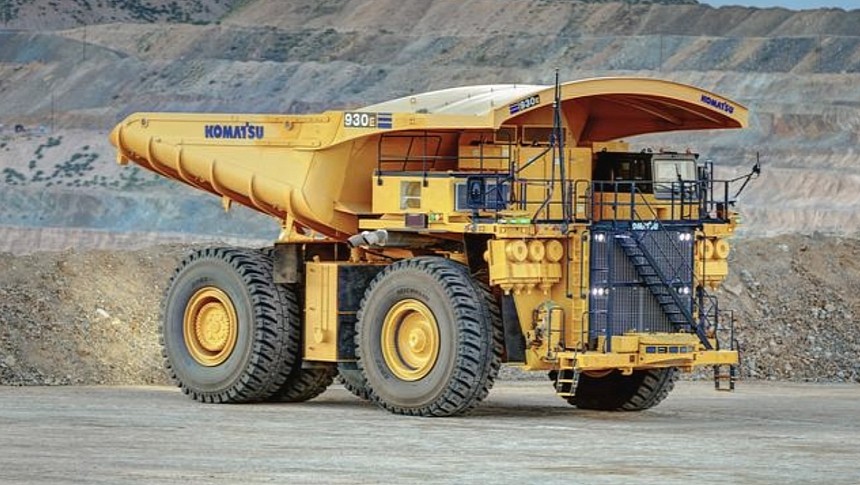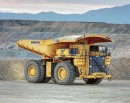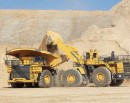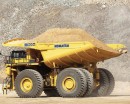GM is taking electrification to a whole new level and straight into the heaviest-duty sector. The automaker partnered up with Komatsu to develop a hydrogen fuel cell power module for the gigantic 930E electric drive mining truck.
Komatsu's 930E mining vehicle is the world's best-selling ultra-class haul truck. The giant looks as if it eats Teslas and anything else that may come its way for breakfast. It is 51.2 feet (15.6 meters) long, 30.2 feet (9.2 meters) wide, and 46 feet (14.02 meters) tall, sporting a wheelbase of 21.1 feet (6.43 meters).
GM tags itself as a leader in hydrogen fuel cell technology. The company has been conducting fuel cell research and product development for more than five decades. It now teams up with Komatsu, which is a global manufacturer of mining and construction equipment, to design, validate, and implement the technology.
The auto giant is thus focusing on heaviest-duty applications that are switching from the usual diesel engines to electrification. Hydrogen fuel cells are an appropriate application since they are lightweight and quick to refuel.
Furthermore, storing large quantities of energy on board the vehicle does not compromise payload carrying capacity. The Komatsu 930E mining truck, with the diesel engine that currently powers it before switching to the upcoming tech, features a nominal payload of 320 tons.
Vehicles such as this one, some of the largest in any industry, usually operate at a single mine throughout their entire life cycle. This reduces the hustle of building up a hydrogen refueling infrastructure to service the fleet.
Charlie Freese, executive director of GM’s Global HYDROTEC business, says that hydrogen fuel cells are best suited for the mining giants. The technology will help mining trucks start on the way to decarbonization beyond battery-trolley or battery-static charging solutions. In addition to this advantage, hydrogen-powered vehicles do not need any charging infrastructure within mines.
Komatsu is targeting the reduction of its global emissions by 50% by 20230. The company also intends to achieve carbon neutrality by 2050. It starts by reducing down to zero emissions of its fleet and manufacturing.
Based on the cross-industry collaboration with GM, Komatsu also offers optimization programs to customers that are interested in progressively reducing emissions. The programs focus on finding new ways to power the equipment that customers need for work of mining and construction.
General Motors also has big plans in terms of carbon neutrality in products as well as operations by 2040.
Before that happens, GM and Komatsu are planning to test the first HYDROTEC-powered mining prototype in mid-2020s at Komatsu's Arizona Proving Grounds (AZPG) research and development center. The mining vehicle will be powered by over 2 megawatts of HYDROTEC power cubes. Right now, the Komatsu 930E is powered by a diesel engine that generates 2,701 horsepower (2,738 PS). But the lineup also includes a more potent variant, rated at 3,500 horsepower (3,548 PS).
GM tags itself as a leader in hydrogen fuel cell technology. The company has been conducting fuel cell research and product development for more than five decades. It now teams up with Komatsu, which is a global manufacturer of mining and construction equipment, to design, validate, and implement the technology.
The auto giant is thus focusing on heaviest-duty applications that are switching from the usual diesel engines to electrification. Hydrogen fuel cells are an appropriate application since they are lightweight and quick to refuel.
Furthermore, storing large quantities of energy on board the vehicle does not compromise payload carrying capacity. The Komatsu 930E mining truck, with the diesel engine that currently powers it before switching to the upcoming tech, features a nominal payload of 320 tons.
Vehicles such as this one, some of the largest in any industry, usually operate at a single mine throughout their entire life cycle. This reduces the hustle of building up a hydrogen refueling infrastructure to service the fleet.
Charlie Freese, executive director of GM’s Global HYDROTEC business, says that hydrogen fuel cells are best suited for the mining giants. The technology will help mining trucks start on the way to decarbonization beyond battery-trolley or battery-static charging solutions. In addition to this advantage, hydrogen-powered vehicles do not need any charging infrastructure within mines.
Komatsu is targeting the reduction of its global emissions by 50% by 20230. The company also intends to achieve carbon neutrality by 2050. It starts by reducing down to zero emissions of its fleet and manufacturing.
Based on the cross-industry collaboration with GM, Komatsu also offers optimization programs to customers that are interested in progressively reducing emissions. The programs focus on finding new ways to power the equipment that customers need for work of mining and construction.
General Motors also has big plans in terms of carbon neutrality in products as well as operations by 2040.
Before that happens, GM and Komatsu are planning to test the first HYDROTEC-powered mining prototype in mid-2020s at Komatsu's Arizona Proving Grounds (AZPG) research and development center. The mining vehicle will be powered by over 2 megawatts of HYDROTEC power cubes. Right now, the Komatsu 930E is powered by a diesel engine that generates 2,701 horsepower (2,738 PS). But the lineup also includes a more potent variant, rated at 3,500 horsepower (3,548 PS).





